List of cat breeds
The following list of cat breeds includes only domestic cat breeds and domestic and wild hybrids. The list includes established breeds recognized by various cat registries, new and experimental breeds, landraces being established as standardized breeds, distinct domestic populations not being actively developed and lapsed (extinct) breeds.
As of 2023, The International Cat Association (TICA) recognizes 73 standardized breeds,[1] the Cat Fanciers' Association (CFA) recognizes 45,[2] the Fédération Internationale Féline (FIFe) recognizes 50,[3] the Governing Council of the Cat Fancy (GCCF) recognizes 45,[4] and the World Cat Federation (WCF) recognizes 69.[5]
Inconsistency in a breed's classification and naming among registries means that an individual animal may be considered different breeds by different registries (though not necessarily eligible for registry in them all, depending on its exact ancestry). For example, TICA's Himalayan is considered a colorpoint variety of the Persian by the CFA, while the Javanese (or Colorpoint Longhair) is a color variation of the Balinese in both the TICA and the CFA; both breeds are merged (along with the Colorpoint Shorthair) into a single "mega-breed", the Colourpoint, by the World Cat Federation (WCF), who have repurposed the name "Javanese" for the Oriental Longhair. Also, "Colo[u]rpoint Longhair" refers to different breeds in other registries. There are many examples of nomenclatural overlap and differences of this sort. Furthermore, many geographical and cultural names for cat breeds are fanciful selections made by Western breeders to be exotic sounding and bear no relationship to the actual origin of the breeds;[6] the Balinese, Javanese, and Himalayan are all examples of this trend.
The domestic short-haired and domestic long-haired cat types are not breeds, but terms used (with various spellings) in the cat fancy to describe "mongrel" or "bicolor" cats by coat length, ones that do not belong to a particular breed. Some registries such as the Cat Fanciers' Association allow for domestic short hairs and domestic long hairs to be registered for the purpose of outcrossing.[7] They should not be confused with standardized breeds with similar names, such as the British Shorthair and Oriental Longhair.
Breeds
[edit]| Breed | Location of origin | Type | Body type | Coat type and length | Coat pattern | Image |
|---|---|---|---|---|---|---|
| Abyssinian[8] | Unspecified, but somewhere in Afro-Asia, likely Ethiopia[9] | Natural | Semi-foreign | Short | Ticked tabby | 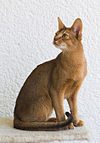
|
| Aegean | Greece | Natural | Moderate | Semi-long | Multi-color | 
|
| American Bobtail[10] | United States[11] | Mutation of shortened tail | Cobby | Semi-long | All | 
|
| American Curl[12] | United States[11] | Mutation | Semi-foreign | Semi-long | All | 
|
| American Ringtail | United States[11] | Mutation | Foreign | Semi-long | All | 
|
| American Shorthair | United States[11] | Natural | Cobby | Short | All | 
|
| American Wirehair | United States[11] | Mutation | Normal | Rex | All | 
|
| Aphrodite Giant | Cyprus | Natural | Lean and muscular | All | All | 
|
| Arabian Mau | Arabian Peninsula | Natural | Moderate and muscular | Short | All | 
|
| Asian | United Kingdom | Crossbreed between the Burmese and Chinchilla Persians | Moderate | Short | All without white and without siamese pointing | 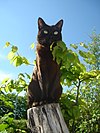
|
| Asian Semi-longhair | United Kingdom | Crossbreed between the Burmese and Chinchilla Persians | Moderate | Semi-long | All without white and without siamese pointing | 
|
| Australian Mist | Australia[13] | Crossbreed between the Abyssinian, Burmese, and Australian short-haired cats[13] | Moderate | Short | Spotted or marbled | 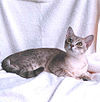
|
| Balinese | Developed in United States;[11] foundation stock from Thailand |
Mutation of the Siamese | Semi-foreign | Long | Colorpoint | 
|
| Bambino | United States[13] | Crossbreed between the Munchkin and Sphynx[13] | Dwarf | Short | Black + white hairless | |
| Bengal | Developed in United States,[13] but created in Asia |
Hybrid of the Abyssinian and Egyptian Mau × leopard cat (Prionailurus bengalensis) | Large | Short | Spotted, marbled, or rosetted | 
|
| Birman | Developed in France; foundation stock from Burma (Myanmar)[11] |
The original Birman was crossed with the Siamese and the Persian to create the Birman of today. | Cobby | Semi-long | Mitted colorpoint | 
|
| Bombay | United States and Burma (Myanmar) | Crossbreed between the Black American Shorthair and Sable Burmese | Cobby | Short | Solid black | 
|
| Brazilian Shorthair | Brazil | Natural | Normal | Short | All | 
|
| British Longhair | United Kingdom (England)[11] | Natural | Cobby | Semi-long | All | 
|
| British Shorthair | United Kingdom (England)[11] | Natural | Cobby | Short | All[14] | 
|
| Burmese | Burma (Myanmar)[11] | Natural | Semi-foreign or semi-cobby | Short | Solid and Tortoiseshell[15] | 
|
| Burmilla | United Kingdom (England)[11] | Crossbreed between the Burmese and the Chinchilla Persian | Semi-cobby | Short | Solid with Shaded Silver and Silver Tipped patterns | 
|
| California Spangled | United States[11] | Crossbreed between the Abyssinian, American Shorthair and British Shorthair | Moderate | Short | Spotted tabby | 
|
| Chantilly-Tiffany | United States | Natural | Cobby | Long | Solid, classic tabby, spotted tabby and ticked tabby | 
|
| Chartreux | France[11] | Natural | Muscular; cobby | Short | Varying shades of blue | 
|
| Chausie | United States | Hybrid of the Abyssinian × jungle cat (Felis chaus) | Normal | Short | Solid black, black grizzled tabby and black ticked tabby | 
|
| Colorpoint Shorthair | United Kingdom (England) | Crossbreed between the Abyssinian, Siamese and short-haired cats | Foreign | Short | Colorpoint | 
|
| Cornish Rex | Cornwall, England,
United Kingdom |
Mutation | Foreign | Rex | All | 
|
| Cymric, Manx Longhair or Long-haired Manx[a] | Isle of Man, United States, and Canada [b][11] | Mutation of the Manx (shortened tail) | Semi-cobby | Long | All | 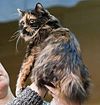
|
| Cyprus | Cyprus | Natural | Lean and muscular | All | All | 
|
| Devon Rex | Buckfastleigh, Devon, England, United Kingdom | Mutation | Semi-foreign | Rex | All | 
|
| Donskoy or Don Sphynx |
Russia | Mutation | Semi-foreign | Hairless | Solid | 
|
| Dragon Li or Chinese Li Hua |
China | Natural | Normal | Short | Ticked tabby | |
| Dwelf | United States | Crossbreed between the American Curl, Munchkin and Sphynx | Dwarf | Hairless | All | |
| Egyptian Mau | Egypt[11] | Natural | Moderate and muscular | Short | Spotted tabby | 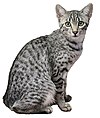
|
| European Shorthair | Continental Europe[11] | Natural | Moderate | Short | All | 
|
| Exotic Shorthair | United States[11] | Crossbreed between the American Shorthair and Persian | Cobby | Short | All | 
|
| Foldex[16] | Canada | Crossbreed between the Exotic Shorthair and Scottish Fold | Cobby | Short | All | 
|
| German Rex | Germany[11] | Mutation | Semi-foreign | Rex | All | 
|
| Havana Brown | United Kingdom (England); foundation stock from Thailand |
Crossbreed between the Siamese and black short-haired cats | Semi-foreign | Short | Solid brown | 
|
| Highlander | United States | Crossbreed between the Desert Lynx and Jungle Curl | Moderate | Short/long | All | 
|
| Himalayan or Colorpoint Persian[c] |
United States and United Kingdom[11] | Crossbreed between the Persian and Siamese | Cobby | Long | Colorpoint | 
|
| Japanese Bobtail | Japan[d][11] | Mutation of shortened tail | Moderate | Short/long | All | 
|
| Javanese or Colorpoint Longhair[e] |
Developed in United States[11] and Canada; foundation stock from Southeast Asia |
Crossbreed between the Balinese (with some Colorpoint Shorthair), Oriental Longhair and Siamese | Oriental | Long | Colorpoint | 
|
| Kanaani | Israel[13] | Hybrid of short-haired cats × African wildcat (Felis lybica) | Semi-foreign | Short | Solid black, chocolate spotted tabby or cinnamon spotted tabby | |
| Karelian Bobtail | Ladoga Karelia, Russia[17] | Natural, mutation of shortened tail[18] | Medium[19] | Short/long[20] | All, except pointed | |
| Khao Manee | Thailand[13] | Natural | Moderate | Short | Solid white | 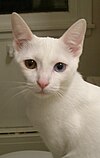
|
| Kinkalow | United States | Crossbreed between the Munchkin and American Curl | Dwarf | Short | All | 
|
| Korat | Thailand[11] | Natural | Semi-foreign or semi-cobby and muscular | Short | Solid blue | 
|
| Korean Bobtail | Korea | Natural, mutation of shortened tail | Moderate | Short/long | All | 
|
| Korn Ja or Konja [citation needed] |
Thailand | Natural | Small | Short | Solid black | |
| Kurilian Bobtail or Kuril Islands Bobtail |
Kuril Islands, North Pacific[13] | Natural, mutation of shortened tail | Semi-cobby | Short/long[13] | All | 
|
| Lambkin | United States[11] | Crossbreed between the Munchkin and Selkirk Rex | Dwarf | Rex | All | |
| LaPerm | United States[11] | Mutation | Moderate | Rex | All | 
|
| Lykoi | United States | Mutation | Moderate | Sparse haired | Black roan | 
|
| Maine Coon | United States[11] | Natural, crossbreed | Large | Semi-long/long | All excluding chocolate and colourpoint | 
|
| Manx | Isle of Man[11] | Mutation of shortened tail | Moderate | Short/long | All | 
|
| Mekong Bobtail | Developed in Russia; foundation stock ultimately from Southeast Asia[13] |
Mutation of shortened tail | Moderate | Short | Colorpoint | 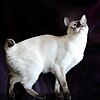
|
| Minskin | United States[13] | Crossbreed between the Munchkin, Burmese, Devon Rex, and Sphynx | Dwarf | Hairless | All | 
|
| Minuet | United States | Crossbreed between the Persian and Munchkin | Dwarf | Short/long | All | 
|
| Munchkin | United States[11] | Mutation of dwarf cat | Dwarf | Short/long | All | 
|
| Nebelung | United States[13] | Natural, mutation | Foreign | Semi-long | Solid blue | 
|
| Neva Masquerade (colorpoint Siberian)[f] | Russia[13] | Crossbreed between the Siberian and a colorpoint cat[22] | Cobby[13] | Long[13] | Colorpoint | 
|
| Norwegian Forest cat | Norway[11] | Natural | Cobby | Long | Chocolate or orange and white bicolor | 
|
| Ocicat | United States[11] | Crossbreed between the Abyssinian, American Shorthair and Siamese | Large | Short | Spotted tabby | 
|
| Ojos Azules (extinct) |
United States[11] | Crossbreed | Moderate | Short | All | 
|
| Oriental Bicolor | Developed in United States and United Kingdom, later in Continental Europe; foundation stock ultimately from Thailand |
Color variety of the Oriental Shorthair | Oriental | Short | Bicolor | 
|
| Oriental Longhair[g] | Developed in United States and United Kingdom; foundation stock ultimately from Thailand[11] |
Crossbreed between the Oriental Shorthair and long-haired cats | Oriental | Semi-long | All; if colorpoint is considered to be a separate breed, it is called the Javanese | 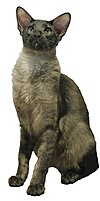
|
| Oriental Shorthair[g] | Developed in United States and United Kingdom; foundation stock ultimately from Thailand[11] |
Crossbreed between the European Shorthair and Siamese | Oriental | Short | All | 
|
| Persian (modern) | Developed in United States and Europe; foundation stock from Greater Iran[11] |
Mutation of the Traditional Persian | Cobby | Long | All but colorpoint | 
|
| Persian (traditional) | Greater Iran[11] | Natural, but some crossbreeding with the Turkish Angora | Cobby | Long | All but colorpoint | 
|
| Peterbald | Russia | Crossbreed between the Donskoy, Oriental Shorthair and Siamese; before this, it was between the Balinese and Javanese |
Oriental | Hairless, velour, brush, or straight coat | All | 
|
| Pixie-bob | United States[11] | Mutation (falsely claimed to be a hybrid of the domestic cat and the bobcat (Lynx rufus) early on) | Medium | Short | Spotted tabby | 
|
| Ragamuffin or Liebling (obsolete) |
United States | Crossbreed between the Ragdoll with limited out-crossing to the Himalayan, the Persian, and other long-haired cats | Cobby | Long | All | 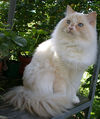
|
| Ragdoll | United States[11] | Behavioral mutation in a crossbreed, presumed to be between the Persian or Turkish Angora and the Birman or Burmese | Cobby | Long | Colorpoint, mitted, or bicolor | 
|
| Raas | Raas Island, Indonesia | Natural | Moderate | Short | Solid blue, solid cinnamon, or cinnamon colorpoint | 
|
| Russian Blue | Russia[11] | Natural | Moderate, Oriental | Short | Solid blue | 
|
| Russian White, Russian Black and Russian Tabby | Developed in Australia; foundation stock from Russia |
Crossbreeds between the Russian Blue and short-haired cats from Siberia, Russia | Moderate | Short | Solid white, solid black and tabby | |
| Sam Sawet | Thailand | Color variety of the Thai | Moderate | Short | Solid | |
| Savannah | United States[13] | Hybrid of the domestic cat x serval (Leptailurus serval)[23] | Large | Short | Spotted | 
|
| Scottish Fold | United Kingdom (Scotland)[11] | Mutation of the bones and cartilage of the ears | Cobby | Short/long | All | 
|
| Selkirk Rex | United States in 1988[11] | Mutation/crossbreed between the American Shorthair, Persian, Himalayan, Exotic Shorthair and British Shorthair | Large and cobby | Short/long (longhair, sometimes in early generations, can appear to be semi-long) | All | 
|
| Serengeti | United States | Crossbreed/hybrid between the Bengal and Oriental Shorthair | Oriental | Short | Spotted | 
|
| Siamese (modern)
) |
Developed in United States and Europe; foundation stock from Thailand[11] |
Mutation of the Thai | Oriental | Short | Colorpoint | 
|
| Siberian or Siberian Forest Cat ) |
Siberian Tundra, Russia. | Natural | Cobby[13] | Long[13] | All; except chocolate, lilac, cinnamon, and fawn[21] | 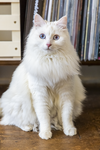
|
| Singapura | Developed in United States; foundation stock from Singapore[11] |
Possibly a mutation of a crossbreed (excluding the Munchkin), solving why they are so small | Small | Short | Ticked tabby | 
|
| Snowshoe | United States[11] | Crossbreed between the American Shorthair and Siamese | Moderate | Short | Mitted colorpoint | 
|
| Sokoke | Kenya[13] | Natural | Moderate | Short | Ticked tabby | 
|
| Somali | United States, Canada | Mutation | Cobby | Long | Ticked tabby | 
|
| Sphynx | Canada, Europe[11] | Mutation | Oriental | Hairless | All | 
|
| Suphalak | Thailand | Natural | Moderate | Short | Solid reddish-brown | 
|
| Thai or Traditional, Classic, or Old-style Siamese; Wichien Maat[h] |
Developed in Europe;[13] foundation stock from Thailand[11] |
Natural | Moderate | Short | Colorpoint | 
|
| Thai Lilac, Thai Blue Point and Thai Lilac Point | Thailand | Color varieties of the Korat | Moderate | Short | Solid lilac and colorpoint (blue point and lilac point only) | 
|
| Tonkinese | Canada, United States[11] | Crossbreed between the Burmese and Siamese | Oriental | Short | Colorpoint, mink, or solid | 
|
| Toybob | Russia | Mutation | Dwarf | Short | All | |
| Toyger | United States[13] | Crossbreed/hybrid between the Bengal and short-haired cats | Moderate | Short | Mackerel tabby | 
|
| Turkish Angora | Turkey[11] | Natural | Semi-cobby | Semi-long | All | 
|
| Turkish Van[i] | Developed in United Kingdom; foundation stock from Turkey[13] |
Natural | Semi-cobby | Semi-long | Van pattern | 
|
| Turkish Vankedisi (white variety of Turkish Van)[i] |
Developed in United Kingdom; foundation stock from Turkey[13] |
Natural | Svelte | Long | Solid white | 
|
| Ukrainian Levkoy | Ukraine | Crossbreed between the Donskoy and Scottish Fold | Moderate | Hairless | Solid gray | 
|
| York Chocolate | New York, United States | Natural | Moderate | Long | Solid chocolate, solid lilac and solid taupe or any of these colors with white | 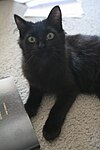
|
See also
[edit]- Animal show
- Animals in sport
- Felidae – the entire cat family
- Felinae – the subfamily of all smaller cat species
- Lists of breeds
- List of experimental cat breeds
- List of cat registries
- List of individual cats
- Selective breeding
- Wildcat – the ancestor of the domestic cat
Explanatory notes
[edit]- ^ The Cymric is often classed as a long-haired variety of the Manx rather than a separate breed, e.g. as the "Semi-longhair Manx Variant" in GCCF.
- ^ There may be some dispute to the exact origins of the Cymric. The specific dominant autosomal gene (M) that causes the short tail of the Cymric was found in the cats living on the Isle of Man in the Irish Sea; however, the breed itself was developed by a Canadian breeder named Blair Wright and an American breeder named Leslie Falteisek in the 1960s from the Isle of Man population.
- ^ Some registries, such as CFA and TICA, classify the Himalayan as a colorpoint variety of the Persian. Others classify it as a long-haired sub-breed of the Siamese. WCF has combined the Himalayan, the Colorpoint Shorthair and the Javanese/Colorpoint Longhair into a single breed, the Colourpoint.
- ^ Due to artifacts and prints dating from as early as the 11th century found in many Eastern countries, there is some likelihood these cats may have originated in China, then were brought to Japan. However, the first known importation of Japanese Bobtails was from Japan in the 1960s.
- ^ "Colorpoint Longhair" has multiple meanings and "Javanese" has been used for at least one other breed; WCF uses the "Javanese" name for the Oriental Longhair (not colorpointed). WCF has also merged the colorpointed Javanese/Colorpoint Longhair, the Himalayan and the Colorpoint Shorthair of other registries into a single breed, the Colourpoint. In CFA and TICA, and some other registries, the Javanese/Colorpoint Longhair has been merged back into the Balinese as a breed division.
- ^ The Neva Masquerade is classified as a separate breed in several (inter)national registries, such as FIFe.[21] However, other registries classify the Neva Masquerade as a natural colorpoint variety of the Siberian cat.
- ^ a b In some registries, including the CFA, the Oriental Shorthair and Oriental Longhair are a single breed, the Oriental, with two divisions (shorthair and longhair).
- ^ Thai is a recently established new name for the original, rounder-faced, thicker-bodied Siamese.
- ^ a b The Turkish Van breed, and especially its "Turkish Vankedisi" variant, are often confused with the Van cat (Van kedisi in Turkish), a landrace (not breed) of cats native to the Lake Van region of Turkey. The Turkish Van and recent "Vankedisi" coat pattern have no known connection to cats from this region, but they are often confused due to the name similarity and incorrect claims sometimes made by breeders.
References
[edit]- ^ "Browse All Breeds". TICA.org. The International Cat Association. 31 July 2018. Archived from the original on 26 January 2022. Retrieved 4 February 2022.
- ^ "CFA Breeds". CFA.org. Cat Fanciers' Association. Archived from the original on 12 January 2022. Retrieved 4 February 2022.
- ^ "FIFe List of Breeds". FIFeWeb.org. Fédération Internationale Féline. Archived from the original on 19 February 2010. Retrieved 25 March 2023.
- ^ "Analysis of Breeds Registered". GCCFCats.org. Governing Council of the Cat Fancy. Retrieved 25 March 2023.
- ^ "WCF Breeds Recognized". WCF.info. World Cat Federation. Retrieved 25 March 2023.
- ^ Somerville, Louisa (2007). The Ultimate Guide to Cat Breeds. Edison, New Jersey: Chartwell Books. p. 44. ISBN 978-0-7858-2264-6.
There is a lot of confusion surrounding the use of this name in the cat world, although it is always used to describe cats of distinctly Oriental type. It has been adopted simply because of the tradition which has grown up for using the names of countries and islands from south-eastern Asia for other Oriental breeds, such as the Siamese and Balinese.
- ^ "Registration Certificate". Catalog.CFA.org. Cat Fanciers' Association. Retrieved 31 December 2023.
- ^ "Abyssinian at a Glance". TICA.org. The International Cat Association. 13 April 2020. Retrieved 20 October 2020.
- ^ "Abyssinian Profile", Catz Inc.. Retrieved 4 October 2009
- ^ "The American Bobtail Breed". 13 April 2020. Retrieved 20 October 2020.
- ^ a b c d e f g h i j k l m n o p q r s t u v w x y z aa ab ac ad ae af ag ah ai aj ak al am an ao ap aq ar as at Paragon, Bernard-Marie; Vaissaire, Jean-Pierre; et al. (2005) [2001, 2003]. The Royal Canin Cat Encyclopedia. Paris: Royal Canin / Aniwa Publishing. This is a four-volume work, but all entries are alphabetical by breed, so volume and page number citations are superfluous.
- ^ "The American Curl Breed". 28 January 2020. Retrieved 20 October 2020.
- ^ a b c d e f g h i j k l m n o p q r s t u v w Baggaley, Ann; Goddard, Jolyon; John, Katie (2014). The Cat Cncyclopedia: The Definitive Visual Guide (1st American ed.). London: Dorling Kindersley. ISBN 978-1-4654-1959-0. OCLC 859882932.
- ^ "British shorthair breed standard" (PDF). GCCFCats.org. Governing Council of the Cat Fancy.
- ^ "Burmese breed introduction". TICA.org. The International Cat Association. Retrieved 28 March 2023.
- ^ "The Foldex". showcatsonline.com. Archived from the original on 24 April 2014. Retrieved 6 June 2015.
- ^ "Карельский бобтейл". zoomir.ru. Retrieved 2 October 2024.
- ^ "Кот и пёс / Kaži da koiru". Республика. Retrieved 2 October 2024.
- ^ "Karelian Bobtail Shorthair". World Cat Federation. Retrieved 2 October 2024.
- ^ "Karelian Bobtail Longhair" (PDF). World Cat Federation. Retrieved 2 October 2024.
- ^ a b "Breed standards Category 2 – Siberian and Neva Masquerade" (PDF). FIFeWeb.org. Fédération Internationale Féline. 1 January 2023. Archived from the original (PDF) on 2 August 2022. Retrieved 20 January 2023.
- ^ World Cat Congress (2017). The Royal Canin Cat Encyclopedia (2nd ed.). Royal Canin. This is a revised one-volume edition, and was only available through RC retailers.
- ^ "Savannah Breed". TICA.org. The International Cat Association. 13 August 2018. Retrieved 4 February 2024.
